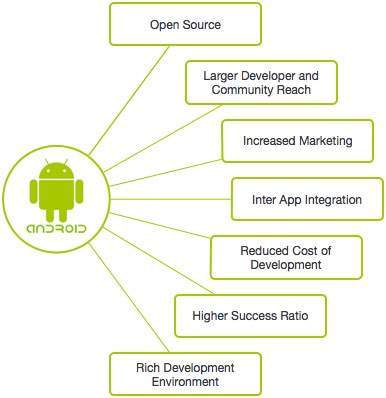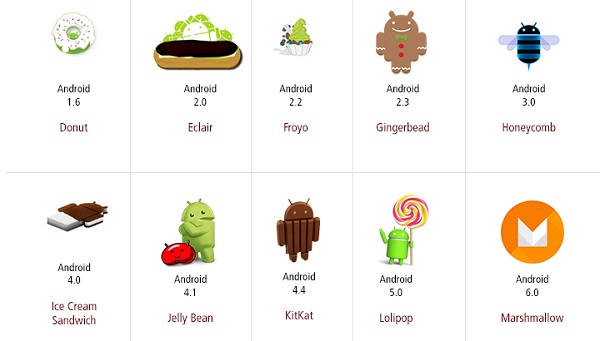An overview of Android Operating System Unique Features
What is Android?
Android is an open source and Linux-based Operating System for mobile devices such as smartphones and tablet computers. Android was developed by the Open Handset Alliance, led by Google, and other companies.
Android offers a unified approach to application development for mobile devices which means developers need only develop for Android, and their applications should be able to run on different devices powered by Android.
The first beta version of the Android Software Development Kit (SDK) was released by Google in 2007 where as the first commercial version, Android 1.0, was released in September 2008.
On June 27, 2012, at the Google I/O conference, Google announced the next Android version, 4.1 Jelly Bean. Jelly Bean is an incremental update, with the primary aim of improving the user interface, both in terms of functionality and performance.
The source code for Android is available under free and open source software licenses. Google publishes most of the code under the Apache License version 2.0 and the rest, Linux kernel changes, under the GNU General Public License version 2.
With Android operating system (OS) KitKat version 4.4 rolling out to mobile devices across the globe, Google is on to something—Android is now more popular than iOS or the Windows phone. The OS tends to garner rave reviews for its ease of use and open source, but many iOS or Windows phone users argue that their preferred operating system can do just as much. In some respects that’s true, but here are 10 features unique to Android’s OS.
1) Near Field Communication (NFC)
Most Android devices support NFC, which allows electronic devices to easily interact across short distances. The main aim here is to create a payment option that is simpler than carrying credit cards or cash, and while the market hasn’t exploded as many experts had predicted, there may be an alternative in the works, in the form of Bluetooth Low Energy (BLE).
2) Alternate Keyboards
Android supports multiple keyboards and makes them easy to install; the SwiftKey, Skype, and 8pen apps all offer ways to quickly change up your keyboard style. Other mobile operating systems either don’t permit extra keyboards at all, or the process to install and use them are tedious and time-consuming.
3) Infrared Transmission
The Android operating system supports a built-in infrared transmitter, allowing you to use your phone or tablet as a remote control.
4) No-Touch Control
Using Android apps such as Wave Control, users can control their phones touch-free, using only gestures. Have messy hands but need to turn off your screen or change a song? Simple. This could prove especially useful if you’re driving, so you can keep both eyes on the road.
5) Automation
The Tasker app lets you not only control app permissions but also automate them. Do you only want your location services to be active during the day? Want to create a customized way to start your music—for example, with a voice command and at a certain volume? Tasker can help.
6) Wireless App Downloads
Accessing app stores on any mobile device can be frustrating, but iOS makes it a little more difficult—download an app on your computer, and it won’t sync to your mobile device until you plug in and access iTunes. Using the Android Market or third-party options like AppBrain, meanwhile, let you download apps on your PC and then automatically sync them your Droid, no plugging required.
7) Storage and Battery Swap
Android phones also have unique hardware capabilities. Google’s OS makes it possible to remove and upgrade your battery or to replace one that no longer holds a charge. In addition, Android phones come with SD card slots for expandable storage.
8) Custom Home Screens
While it’s possible to hack certain phones to customize the home screen, Android comes with this capability from the get-go. Download a third-party launcher like Nova, Apex or Slide and you can add gestures, new shortcuts, or even performance enhancements for older-model devices.
9) Widgets
Apps are versatile, but sometimes you want information at a glance instead of having to open an app and wait for it to load. Android widgets let you display just about any feature you choose, right on the home screen—including weather apps, music widgets, or productivity tools that helpfully remind you of upcoming meetings or approaching deadlines.
10) Custom ROMs
This is a big one. Because the Android operating system is open source, developers can tweak the current OS and build their own versions, which users can download and install in place of the stock OS. Some are filled with features, while others change the look and feel of a device. Chances are if there’s a feature you want, someone has already built a custom ROM for it.
Android offers a host of options not found in comparable mobile operating systems. What’s your favorite Android-only feature?
Why Android ?

Features of Android
Android is a powerful operating system competing with Apple 4GS and supports great features. Few of them are listed below −
| Sr.No. | Feature & Description |
|---|---|
| 1 |
Beautiful UI
Android OS basic screen provides a beautiful and intuitive user interface.
|
| 2 |
Connectivity
GSM/EDGE, IDEN, CDMA, EV-DO, UMTS, Bluetooth, Wi-Fi, LTE, NFC and WiMAX.
|
| 3 |
Storage
SQLite, a lightweight relational database, is used for data storage purposes.
|
| 4 |
Media support
H.263, H.264, MPEG-4 SP, AMR, AMR-WB, AAC, HE-AAC, AAC 5.1, MP3, MIDI, Ogg Vorbis, WAV, JPEG, PNG, GIF, and BMP.
|
| 5 |
Messaging
SMS and MMS
|
| 6 |
Web browser
Based on the open-source WebKit layout engine, coupled with Chrome's V8 JavaScript engine supporting HTML5 and CSS3.
|
| 7 |
Multi-touch
Android has native support for multi-touch which was initially made available in handsets such as the HTC Hero.
|
| 8 |
Multi-tasking
User can jump from one task to another and same time various application can run simultaneously.
|
| 9 |
Resizable widgets
Widgets are resizable, so users can expand them to show more content or shrink them to save space.
|
| 10 |
Multi-Language
Supports single direction and bi-directional text.
|
| 11 |
GCM
Google Cloud Messaging (GCM) is a service that lets developers send short message data to their users on Android devices, without needing a proprietary sync solution.
|
| 12 |
Wi-Fi Direct
A technology that lets apps discover and pair directly, over a high-bandwidth peer-to-peer connection.
|
| 13 |
Android Beam
A popular NFC-based technology that lets users instantly share, just by touching two NFC-enabled phones together.
|
Android Applications
Android applications are usually developed in the Java language using the Android Software Development Kit.
Once developed, Android applications can be packaged easily and sold out either through a store such as Google Play, SlideME, Opera Mobile Store, Mobango, F-droid and the Amazon Appstore.
Android powers hundreds of millions of mobile devices in more than 190 countries around the world. It's the largest installed base of any mobile platform and growing fast. Every day more than 1 million new Android devices are activated worldwide.
This tutorial has been written with an aim to teach you how to develop and package Android application. We will start from environment setup for Android application programming and then drill down to look into various aspects of Android applications.
Categories of Android applications
There are many android applications in the market. The top categories are −

History of Android
The code names of android ranges from A to N currently, such as Aestro, Blender, Cupcake, Donut, Eclair, Froyo, Gingerbread, Honeycomb, Ice Cream Sandwitch, Jelly Bean, KitKat, Lollipop and Marshmallow. Let's understand the android history in a sequence.

What is API level?
API Level is an integer value that uniquely identifies the framework API revision offered by a version of the Android platform.
| Platform Version | API Level | VERSION_CODE | |
|---|---|---|---|
| Android 6.0 | 23 | MARSHMALLOW | |
| Android 5.1 | 22 | LOLLIPOP_MR1 | |
| Android 5.0 | 21 | LOLLIPOP | |
| Android 4.4W | 20 | KITKAT_WATCH | KitKat for Wearables Only |
| Android 4.4 | 19 | KITKAT | |
| Android 4.3 | 18 | JELLY_BEAN_MR2 | |
| Android 4.2, 4.2.2 | 17 | JELLY_BEAN_MR1 | |
| Android 4.1, 4.1.1 | 16 | JELLY_BEAN | |
| Android 4.0.3, 4.0.4 | 15 | ICE_CREAM_SANDWICH_MR1 | |
| Android 4.0, 4.0.1, 4.0.2 | 14 | ICE_CREAM_SANDWICH | |
| Android 3.2 | 13 | HONEYCOMB_MR2 | |
| Android 3.1.x | 12 | HONEYCOMB_MR1 | |
| Android 3.0.x | 11 | HONEYCOMB | |
Android 2.3.4
Android 2.3.3
| 10 | GINGERBREAD_MR1 | |
Android 2.3.2
Android 2.3.1
Android 2.3
| 9 | GINGERBREAD | |
| Android 2.2.x | 8 | FROYO | |
| Android 2.1.x | 7 | ECLAIR_MR1 | |
| Android 2.0.1 | 6 | ECLAIR_0_1 | |
| Android 2.0 | 5 | ECLAIR | |
| Android 1.6 | 4 | DONUT | |
| Android 1.5 | 3 | CUPCAKE | |
| Android 1.1 | 2 | BASE_1_1 | |
| Android 1.0 | 1 | BASE |

No comments